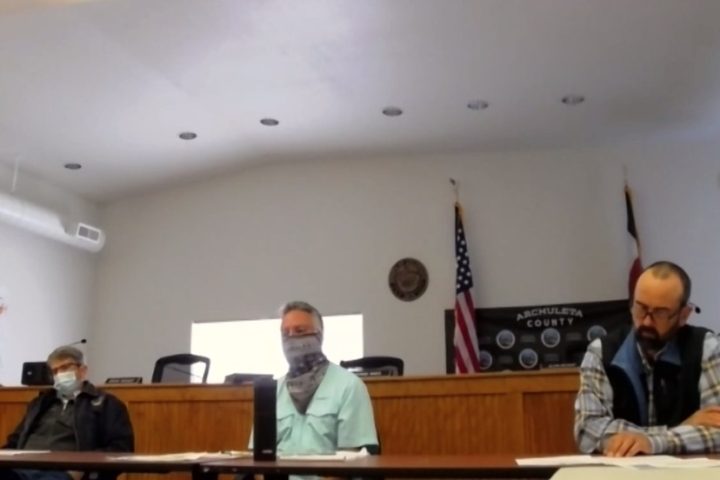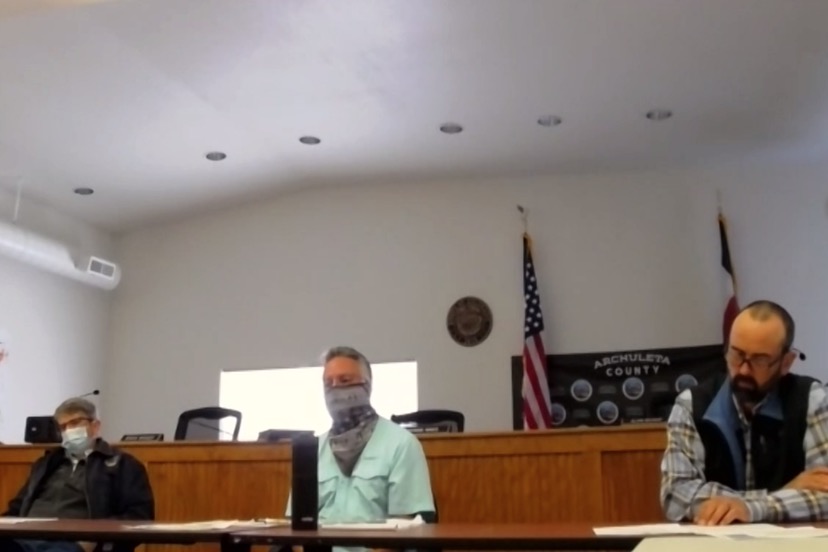Each county, by resolution of its board of county commissioners, shall establish and maintain a county public health agency or shall participate in a district public health agency…
— Colorado Revised Statutes, 25-1-506.
I hear reports that domestic violence is on the rise, during the current public health emergency. People are having trouble getting along, it would seem. Even married people. Too much time on our hands? Frayed nerves, perhaps?
On November 17, the Archuleta Board of County Commissioners — Alvin Schaaf, Ronnie Maez and Steve Wadley — unanimously approved a (somewhat controversial?) resolution proposing significant changes to the BOCC’s relationship with San Juan Basin Public Health District. SJBPH is the agency responsible for promoting public health in two neighboring counties: La Plata and Archuleta.
We will mention, right out of the gate, that these two neighboring counties tend to lean in different political directions. La Plata County, for example, cast 58% of its votes for presidential candidate Joe Biden, and only 40% for Donald Trump. Next door in Archuleta County, the results were pretty much flipped, with 57% of the presidential votes going to Donald Trump and 41% going to Joe Biden.
Two counties that might view the world differently? And have trouble getting along?
Colorado law requires every county government to maintain a public health service. According to its website, SJBPH “has improved the health and environment of the Southwest Colorado community” for the past 70 years, although I cannot verify whether Archuleta County, per se, has been served for that length of time.
The duties assigned to local public health agencies are numerous, but we will note, in particular, the following duties, specified in CRS 25-1-506:
(V) To investigate and control the causes of epidemic or communicable diseases and conditions affecting public health;
(VI) To establish, maintain, and enforce isolation and quarantine, and in pursuance thereof, and for this purpose only, to exercise physical control over property and over the persons of the people within the jurisdiction of the agency as the agency may find necessary for the protection of the public health;
(VII) To close schools and public places and to prohibit gatherings of people when necessary to protect public health;
(VIII) To investigate and abate nuisances when necessary in order to eliminate sources of epidemic or communicable diseases and conditions affecting public health;
And since we are noting things, we will also note that, during recent BOCC meetings, Commissioner Alvin Schaaf has attended open public meetings without wearing a face covering as required by recent Colorado state public health orders.

I sent Commissioner Schaaf an email last week, wondering why he appears at indoor public meetings without a mask, but I’ve not heard anything back. It’s possible Commissioner Schaaf suffers from respiratory issues — one of the exemptions allowed from the state mask mandate.
Commissioner Schaaf represents the Archuleta BOCC on the SJBPH Board of Health, the body that makes policy decisions regarding the district’s operations. We don’t know, however, how involved Commissioner Schaaf may have been in the composition of the November 17 resolution. He tends to keep his thoughts to himself, during BOCC meetings… but he did express some concerns, during a ZOOM meeting last month, about the high cost of septic system approvals handled by SJBPH. That particular issue appeared in the resolution as follows:
7. SJBPH shall prepare a comprehensive review of all expenses and revenues for the septic permit and inspection services provided to Archuleta County. In addition, SJBPH will provide an action plan to reduce fees and improve services to users.
I will be discussing the other six requests included in the November 17 BOCC resolution, but we can start with Number 7.
The first two houses I lived in, upon arriving in Pagosa Springs in 1993, had been built in the downtown core area about 90 years earlier, and were originally serviced by outhouses, rather than flush toilets. I am guessing that flush toilets were probably added around 1960, based on the testimony of a friend who lived in Pagosa during the 1950s and who was familiar with our first house on Lewis Street.
In the 1970s, developers began to buy up ranch properties in what is now the Pagosa Lakes area, and ultimately designed 21 square miles of suburban subdivisions with centralized drinking water delivery and sanitation services to be provided by the newly-formed Pagosa Area Water and Sanitation District. A bit further west, developers had created the Aspen Springs subdivision without any water or sanitation services. Several other suburban developments — such as Alpha, Loma Linda, and San Juan River Village — either connected to PAWSD water and sewer, or formed their own centralized water and sanitation systems.
Along the way, PAWSD and the Town of Pagosa Springs realized that water and sewer connections to new subdivisions were being essentially ‘subsidized’ by existing customers, and both agencies substantially increased both the cost of new hook-ups and the burden of regulations.
One example of how that has played out.
Recently, developer Jack Searle approached PAWSD and the Town for approval of a new subdivision at the southeast corner of downtown: the River Rock Estates subdivision. Mr. Searle had at first envisioned the vacant 16-acre parcel to be suitable for dozens of homes priced for moderate-income families. But upon learning the current cost of water and sewer connections, Mr. Searle tossed out the idea of a ‘neighborhood’ and decided to limit the subdivision plat to only ten parcels, priced for millionaires.
The vacant 16-acre parcel was purchased for $1.5 million. The ten platted lots — each measuring about 1.5 acres — are now priced at about $550,000 each. According to my pocket calculator, Mr. Searle and River Rock Estates LLC hope to bring in about $4 million more than the parcel’s original purchase price, not including the cost of developing the street and utilities that will service the subdivision.
Under Colorado law, subdivision parcels smaller than 35 acres must be connected to sewer systems, be they centralized systems or individual septic systems.
It’s not cheap to hook up new properties to water and sewer in Archuleta County. Nor is it cheap, in some cases, to purchase a vacant parcel of land. I purchased my first house in downtown Pagosa in 1993 for $52,000. One of my new next-door neighbors has just begun building a house, and he paid $160,000 for a vacant lot. That price doesn’t include the water and sewer hook-ups, nor the other development fees collected by our local governments, nor the cost of the house construction.
The more affordable parcels in Archuleta County are located out in the more rural parts of the community and are not served by running water, or by centralized sanitation, so they rely on OSWT (On Site Wastewater Treatment) systems.
Septic systems.
I understand that SJBPH is currently charging $1,000 for a typical septic system permit, and the system itself might then cost somewhere around $20,000 – $30,000 to install. Ouch.
Who can afford to build a new house in Archuleta County… unless they are unusually wealthy?

